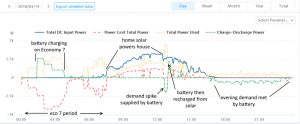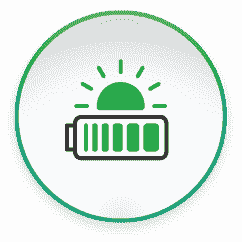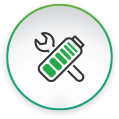Saving Money
Having a home battery allows you to use your free solar instead of paying for electricity from the grid – the battery automatically stores any of your spare solar electricity that would otherwise have gone out to the grid. This is particularly valuable if you are out during the day and not able to use all the solar you generate.
With a battery charged from solar you can run your home in the evening and overnight for free. With a large enough solar array and battery you can cover all your electricity needs until your solar starts up again the next day, at least for most of the year.
A less obvious benefit of having even a small battery is that it smooths out your solar generation. For example, even if you are able to run your washing machine during the day mostly on solar, you will pay for electricity every time the sun goes behind a cloud – a battery fills in these gaps.
There are 5 other main ways a home battery can save you money:
- Cheap winter electricity: With a programmable home battery (like our PowerBanx systems) you have the option of charging the battery from half-price Economy 7 electricity in the winter when your solar generation is reduced. Further details are here.
- Fixed costs: a one-off battery purchase means that you are not impacted as much by the ever increasing price of electricity.
- Feed-in-tariff (if you have solar and get FIT payments): in most cases you are still entitled to receive your FIT payment and your export payment even if you use a battery to consume all the solar you generate.
- You can take advantage of time-of-use (TOU) tariffs which have low costs most of the day but a high cost at certain times – and the battery can be used to power the house during these periods.
- You can charge an electric vehicle (EV) from low cost electricity stored in the battery whenever you want, rather than having to charge just when the grid is cheap.
Power Cut Backup
With a home battery you have options for keeping the lights on and your food safe during a power cut. These range from a simple double socket that goes live during a power cut all the way up to a complete home backup system (so you can’t even tell a power cut happened).
Full details are covered here: Power Cut Backup Options with Battery Storage
Environmental
Having a home battery allows you to use more of your own home generated solar rather than using electricity from the grid (which is less than half renewable), so reducing your personal carbon footprint.
It can also be used to ‘tide you over’ the evening peak period when the demand on the grid is the highest and more grid electricity is created from fossil fuels (coal and gas).
Monitoring
Most home battery systems come with advanced monitoring features, both hardware and software:
- The battery inverter part of the system provides a screen display that shows in real-time your solar generation, home electricity consumption, battery charging level and grid import/export power.
- When connected via WiFi you can also monitor these values online, and on your smartphone.
You can also typically view this data in charts, both in real-time and looking back historically (by day, week, month and year).
This means you have the data you need to make informed decisions about how to save costs, time shift usage, and evaluate expanding your solar and battery, operating an EV, and so on.










